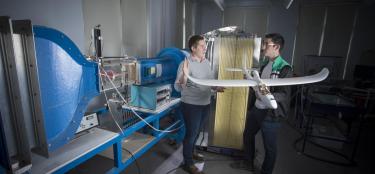WPI’s Master’s in Aerospace Engineering online is designed for professionals advancing their careers through graduate education while balancing their work responsibilities. Offered full and part-time, graduate students can continue their studies while benefiting from the flexibility of high-quality remote learning. This program is delivered by faculty members who are not only engaged in wide-ranging, cutting-edge research in aerospace topics, but are dedicated teachers sensitive to the educational goals and individual needs of their students.
The modern curriculum consists of graduate courses distributed in five areas:
- Fluid dynamics
- Propulsion and energy
- Flight dynamics and controls
- Materials and structures
- General aerospace engineering topics
The online master’s in aerospace engineering also provides the flexibility for students to specialize in a curricular area by focusing their elective courses. For students wishing to gain research experience, this program allows up to 8-credits of Directed Research, of which up to 3 may be in Graduate Internship Experience on topics encountered in their professional environment. Courses are 7 weeks in length, offering greater flexibility for students who need to adjust their workloads and whose professional or personal lives may not permit lengthy semester-long commitments.
This program is also available on campus
Learn moreLearning Outcomes for Master’s in Aerospace Engineering Online
With a deeper understanding of technical concepts and with an array of technical skills well beyond the limits of an undergraduate degree, graduates of the master’s in Aerospace Engineering online will excel as practicing industry professionals and will have the backgrounds needed to contribute to the research and development of next-generation aerospace systems. Graduates of our program will succeed in any interdisciplinary industrial, R&D or national lab setting.
Students who earn their MS in Aerospace Engineering Online will be able to:
-
Demonstrate graduate-level knowledge of fluid dynamics, propulsion and energy, flight dynamics and control, materials and structures, and other engineering topics, as appropriate to their professional interests;
-
Apply the theoretical and computational skills and solve complex, real-world aerospace engineering problems;
-
Express the appreciation of current developments and outstanding issues in aerospace engineering.
Grad Studies Blog
Explore Catalyst, our graduate school blog, where you’ll find student stories, expert insights, and answers to common questions. Whether you’re a prospective, admitted, or current grad student, it’s your go-to source for STEM perspectives, career advice, and essential tips—all in one place.
Graduate Studies Series
Team members from Graduate & Professional Studies host quick and convenient webinars designed to highlight popular topics when starting grad school. Take a deep dive into specific areas of interest such as how to secure funding, how to ace your application, an overview of student services, and more!
Admissions Qualifications
- Candidates must have a BS degree in Aerospace Engineering or a closely related field.
- Candidates with graduate certificates, undergraduate or graduate coursework relevant to the Aerospace Engineering M.S. curriculum are also encouraged to apply.
For specific application requirements, visit application requirements page
Program Requirements
The online aerospace engineering degree requires the completion of 30 graduate credit hours. The distribution of credits is as follows:
- 20-credits in Aerospace Engineering
- A minimum of 2-credits in each of the five AE Curricular Areas: Fluid Dynamics; Propulsion and Energy; Flight Dynamics and Controls; Materials and Structures; General Aerospace Engineering Topics
- A maximum of 8-credits in AE Research, of which up to 3 may be in Graduate Internship Experience (AE 5900) and the remaining in Directed Research (AE 5098)
- 0 graduate credits for four terms in Aerospace Engineering Seminar (AE 5032)
- 10-credits in electives
- 8 graduate credits in free electives inside or outside AE
- 2 graduate credits in applied mathematics (MA 501, MA 511, or any other course with the prior approval of AE graduate committee)
TOTAL: 30 Credits
Courses
All Aerospace Engineering graduate courses are 2 credits, unless otherwise noted below.
Fluid Dynamics
- AE 5131. Incompressible Fluid Dynamics
- AE 5132. Compressible Fluid Dynamics
- AE 5133. Kinetic Theory of Gases and Applications
- AE 5134. Plasma Dynamics
Propulsion and Energy
- AE 5231. Air Breathing Propulsion
- AE 5232. Spacecraft Propulsion
- AE 5233. Combustion
- AE 5234. Sustainable Energy Systems
Flight Dynamics and Controls
- AE 5331. Linear Control Systems
- AE 5332. Nonlinear Control Systems
- AE 5333. Optimal Control for Aerospace Applications
- AE 5334. Spacecraft Dynamics and Control
- AE 5335. Autonomous Aerial Vehicles
Materials and Structures
- AE 5431. Solid Mechanics for Aerospace Structures
- AE 5432. Composite Materials
- AE 5433. Aeroelasticity
- AE 5434. Computational Solid Mechanics
- AE 5435. Fracture Mechanics
General Aerospace Engineering Topics
- AE 5031. Applied Computational Methods for Partial Differential Equations
- AE 5032. Aerospace Engineering Seminar (0 credits)
AE Research Courses
- AE 5098. Directed Research (credits TBD)
- AE 5900. Graduate Internship Experience (1-3 credits)
To find the next offering of online Aerospace Engineering courses, visit the Registrar’s site.
To view a course description, visit the Graduate Catalog.
Subject to change based on availability.
Aerospace Engineering: Career Outcomes
What does a career in Aerospace Engineering look like? Browse WPI and national data to learn more about companies who have hired WPI graduate, average salaries, job outlook, and more.
Experiential PhD: Working Full-Time While Pursuing Your PhD Degree
WPI supports individuals working full-time in industry to pursue PhD degrees either part-time or full-time on topics related to their employment. Want to learn more about this opportunity and how to obtain this industry-based PhD degree, visit the WPI Experiential PhD program page.
Have questions?
WPI's dedicated graduate student support team can help.
Refer a Friend
Do you have a friend, colleague, or family member who might be interested in a WPI graduate program? Click below to tell them about our programs.
From on-site recruiting events to live and on-demand webinars, learn more and stay connected with WPI’s Graduate & Professional Studies.
Take a Course
Not sure if online learning works for you? Try a course to see if this program delivery is right for you.
